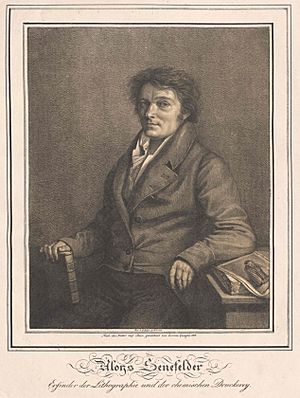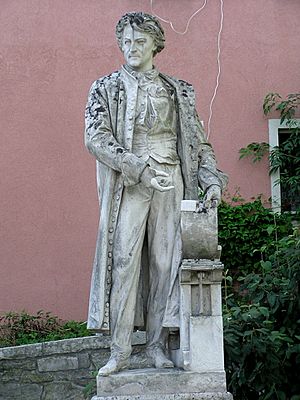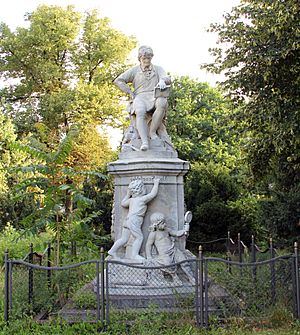Alois Senefelder facts for kids
Quick facts for kids
Alois Senefelder
|
|
|---|---|

Lithograph of Senefelder, from Specimens of Polyautography.
|
|
| Born |
Aloys Johann Nepomuk Franz Senefelder
6 November 1771 |
| Died | 26 February 1834 (aged 62) Munich, Kingdom of Bavaria
|
| Nationality | German |
| Known for | Inventing lithography |
Alois Senefelder (born November 6, 1771 – died February 26, 1834) was a German inventor. He created a special printing method called lithography in the 1790s. This invention changed how books, pictures, and newspapers were made.
Contents
Early Life and Big Idea
Alois Senefelder was born in Prague, which was then part of the Kingdom of Bohemia. His father was an actor. Alois studied law in Munich. But when his father passed away in 1791, Alois had to stop his studies. He needed to help his mother and eight brothers and sisters. So, he became an actor and wrote plays.
One of his plays, Mathilde von Altenstein, was hard to print. Alois got into debt because of this. He couldn't afford to publish his new play. This problem made him think about new ways to print.
How Lithography Was Born

Senefelder started experimenting with a special kind of stone. This stone was Solnhofen limestone. He used a greasy, acid-resistant ink on the smooth stone. He found a way to print from the flat surface of the stone itself. This was a completely new way of printing. It was the first "planographic" process. This means printing from a flat surface, not raised or carved.
He worked with the André family, who were music publishers. Together, they made his new technique better. They improved the chemicals and the special printing press needed for the stones. Senefelder first called it "stone printing." But the French name, "lithography," became more popular. In 1796, he even started a publishing company using lithography with composer Franz Gleißner.
Lithography Spreads Across Europe
People quickly saw how useful lithography was. It was cheap and could make exact copies. Land surveying offices all over Europe started using it. In 1809, Senefelder became the Inspector of a new "Lithographic Institute" in Munich, Bavaria. Similar institutes were later set up in Berlin, Paris, London, and Vienna, all under his guidance.
Senefelder got patent rights for his invention across Europe. He also wrote a book in 1818 called Vollstandiges Lehrbuch der Steindruckerei. This book was translated into French and English in 1819. The English version, A Complete Course of Lithography, told the story of his invention. It also gave practical tips on how to do lithography. This book was still being printed as recently as 1977!
Lithography in Art
Lithography was also great for art. Before this, printmaking methods like engraving needed special skills. But with lithography, artists could draw directly onto the stone. They could use their usual pens and brushes. This made it easier to create detailed and varied artwork. As early as 1803, a collection of artists' lithographs was published in London. It was called Specimens of Polyautography.
Later, in 1837, lithography was improved even more. It could print full-color images using many plates. This method was called chromolithography. It was the most important way to print in color until modern process color printing came along.
Awards and Lasting Impact
King Maximilian Joseph of Bavaria honored Senefelder for his invention. There is a statue of him in Solnhofen, the town where the special lithographic stone is still found. Another statue of Alois Senefelder was put up in Berlin in 1892. The square where it stands was renamed Senefelderplatz in 1894. There's even a subway station called Senefelderplatz that opened in 1913.
Alois Senefelder's invention was as important as other big printing breakthroughs. These include William Ged's stereotyping, Friedrich Koenig's steam press, and Ottmar Mergenthaler's linotype machine. Lithography made printing cheaper and available to more people. It was very important for art and newspapers. Senefelder lived to see his invention used widely. He passed away in Munich and is buried there.
Some plants have even been named after him! These include the plant groups Senefeldera and Senefelderopsis.
See also
 In Spanish: Aloys Senefelder para niños
In Spanish: Aloys Senefelder para niños
- Johann André
- List of German inventors and discoverers


